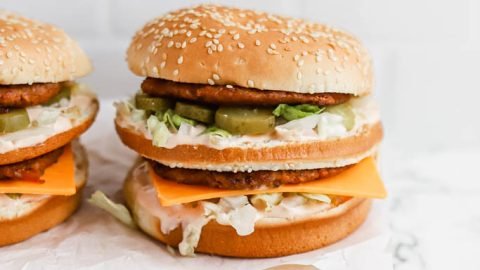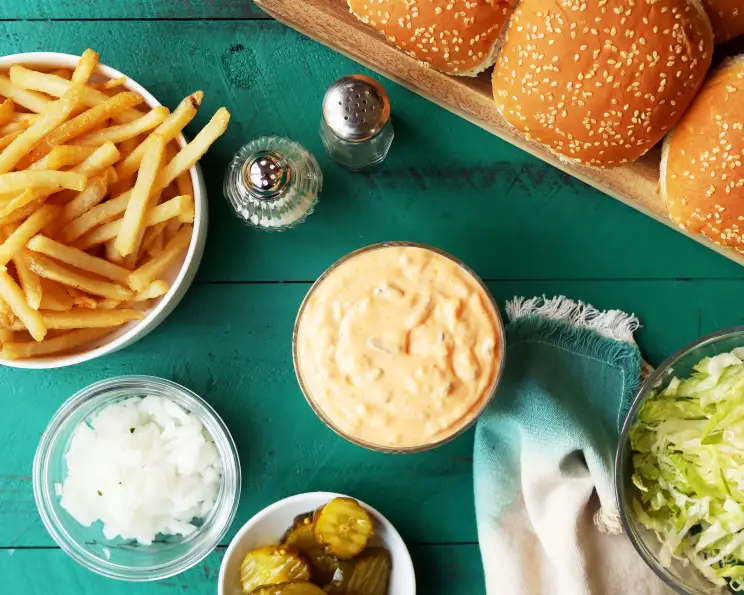Mcdonald’s Big Mac Sauce Copycat Recipe
McDonald’s Big Mac has been a hallmark of fast-food culture since its inception in 1967. The iconic sandwich, with its three-part sesame seed bun, seasoned beef patties, lettuce, pickles, onions, and signature Big Mac Sauce, has become one of the most recognizable fast-food items in the world. Of all the ingredients that make the Big Mac a beloved classic, it’s the special sauce that has piqued the curiosity of many fans. This creamy, tangy, and slightly sweet dressing is the perfect complement to the burger’s savory elements, making it a critical component of the sandwich’s unique taste.
While McDonald’s has kept the precise recipe for Big Mac Sauce under wraps for decades, the demand for a copycat version has grown exponentially. Food enthusiasts and copycat recipe creators have developed their own interpretations of the famous sauce, seeking to recreate the flavors that have helped propel the Big Mac into iconic status.
In this article, we will explore the origins of the Big Mac Sauce, delve into the components that make it so distinct, and provide a detailed copycat recipe so that you can enjoy this fast-food staple from the comfort of your own home. Whether you’re a Big Mac aficionado or simply someone looking to recreate that special sauce, this guide will walk you through the steps of making an authentic and flavorful version that mirrors McDonald’s beloved condiment.
The Origins of the Big Mac Sauce
The Big Mac Sauce was first introduced in 1968, just a year after the Big Mac itself debuted at McDonald’s. Developed by the chain’s then-Executive Chef, Herb Lotman, the sauce was intended to give the burger a unique flavor profile that would set it apart from other fast-food offerings at the time. The original idea for the Big Mac was to create a double-decker burger, with two all-beef patties, lettuce, cheese, pickles, onions, and a special sauce, all held together by a three-piece sesame seed bun. This combination quickly became a favorite, and it was the sauce that made the Big Mac stand out among its competitors.
Though McDonald’s has never fully disclosed the specific ingredients of the Big Mac Sauce, they have confirmed that it is a mayonnaise-based sauce with relish, mustard, and a variety of spices. Over the years, the sauce has remained largely unchanged, and its recipe is one of the most closely guarded secrets in the fast-food industry.
However, in the late 20th and early 21st centuries, people began experimenting with recreating the Big Mac Sauce at home. Various food bloggers, chefs, and even McDonald’s fans have posted their own renditions, attempting to match the signature tang and creaminess of the sauce. While the exact recipe remains a mystery, many copycat versions have managed to replicate the taste fairly accurately.
The Secret Ingredients: What Makes Big Mac Sauce So Unique?
The key to the Big Mac Sauce’s distinctive flavor lies in its combination of ingredients, which come together to create a tangy, creamy, and slightly sweet condiment that pairs perfectly with the Big Mac’s savory components. While McDonald’s keeps the specific proportions and ingredients a secret, culinary experts and food enthusiasts have analyzed the sauce and identified some core elements that make it so special.
1. Mayonnaise Base:
The foundation of Big Mac Sauce is mayonnaise, which provides a rich, creamy texture that serves as a perfect carrier for the other flavors. Mayonnaise itself is made from oil, egg yolks, and vinegar, which contribute to its smooth, emulsified consistency. In the Big Mac Sauce, the mayo’s richness balances the other ingredients and gives the sauce its signature creamy mouthfeel.
2. Sweet Relish:
Sweet relish plays an essential role in Big Mac Sauce, providing a mild sweetness and a touch of tanginess. The small, finely chopped pieces of pickle or relish in the sauce contribute a burst of flavor that contrasts with the creaminess of the mayo. Relish is a common ingredient in many fast-food sauces, as it helps enhance the overall taste with its sharp yet sweet profile.
3. Mustard:
The addition of mustard gives the Big Mac Sauce a subtle tang and a bit of sharpness. Mustard is often used in fast-food sauces to provide a zesty note that cuts through the richness of the mayo. In Big Mac Sauce, it helps balance out the sweetness of the relish and adds a depth of flavor that makes the sauce more complex.
4. Vinegar:
Vinegar is another critical component that helps enhance the tangy profile of Big Mac Sauce. It adds acidity and brightness, giving the sauce a fresh, slightly sour flavor that helps cut through the richness of the mayo. The vinegar’s tartness also complements the sweetness of the relish, creating a harmonious balance of flavors.

5. Onion Powder and Garlic Powder:
Onion powder and garlic powder are subtle yet essential seasonings that add depth to the flavor profile of Big Mac Sauce. These savory ingredients contribute a mild, aromatic undertone that enhances the overall flavor without overpowering the other elements. They also help to mimic the savory, umami notes that you would typically find in other fast-food sauces.
6. Paprika:
Paprika adds a touch of smokiness and color to the sauce. While it doesn’t contribute a strong flavor, it enhances the overall appearance of the sauce and adds a hint of warmth. Paprika’s mild smokiness helps tie the sauce’s flavor together, making it more complex.
7. Sugar:
A small amount of sugar is added to the sauce to balance the acidity of the vinegar and mustard, as well as to enhance the sweetness from the relish. This subtle sweetness is one of the reasons why the sauce has such a distinct flavor that is both savory and sweet.
8. Salt:
As with any sauce or seasoning, salt is an essential ingredient for bringing the flavors together. It helps to accentuate the other components of the sauce and ensures that the taste is well-rounded and satisfying.
How to Make McDonald’s Big Mac Sauce at Home: A Step-by-Step Guide
Recreating McDonald’s Big Mac Sauce at home is easier than you might think. With a few basic ingredients that are likely already in your pantry, you can prepare a copycat version of this iconic sauce that rivals the original in taste and texture. Below is a step-by-step guide to making your own Big Mac Sauce from scratch.
Ingredients:
- 1/2 cup mayonnaise (preferably full-fat for the creamiest texture)
- 2 tablespoons French dressing (or ketchup as a substitute)
- 1 tablespoon yellow mustard
- 1 tablespoon sweet pickle relish
- 1 teaspoon white vinegar
- 1/2 teaspoon garlic powder
- 1/2 teaspoon onion powder
- 1/2 teaspoon paprika
- 1 teaspoon sugar
- Salt and pepper to taste
Instructions:
- Prepare the Base: Start by placing the mayonnaise in a medium-sized bowl. This will be the creamy base of the sauce.
- Add the French Dressing: Add the French dressing (or ketchup if using) to the bowl. This will provide a tangy sweetness that complements the other ingredients. French dressing is a common ingredient in copycat recipes for Big Mac Sauce, as it mimics the subtle sweet and tangy flavors.
- Incorporate the Mustard: Stir in the yellow mustard, which will give the sauce its signature tang and depth of flavor. Mustard is a crucial component in achieving the signature Big Mac Sauce taste.
- Add Sweet Relish: Stir in the sweet pickle relish. This ingredient adds a mild sweetness and a touch of tartness, mimicking the flavor of the pickles on the Big Mac.
- Season with Vinegar and Spices: Add the white vinegar, garlic powder, onion powder, paprika, and sugar. The vinegar adds acidity, while the spices contribute savory and aromatic elements to the sauce. The sugar helps balance the tartness and adds a hint of sweetness to the overall flavor.
- Mix Thoroughly: Stir all the ingredients together until they are well combined. Taste the sauce and adjust the seasoning if necessary, adding salt, pepper, or more sugar to balance the flavors to your liking.
- Let it Sit: For the best results, cover the sauce and refrigerate it for at least 30 minutes before serving. This allows the flavors to meld together and enhances the overall taste.
- Serve: Use the sauce as a topping for burgers, sandwiches, or fries, just like McDonald’s Big Mac. This copycat Big Mac Sauce is also excellent on salads, wraps, or even as a dipping sauce for vegetables.
Flavor Profile and Sensory Experience of Big Mac Sauce
The appeal of McDonald’s Big Mac Sauce lies in its ability to balance contrasting flavors in a harmonious and satisfying way. The rich creaminess of the mayo base is complemented by the tangy bite of mustard, the subtle sweetness of the relish, and the aromatic savory spices. Each spoonful offers a delightful sensory experience that enhances the overall taste of the Big Mac.
Creaminess:
The mayo base provides a velvety smoothness that coats the other ingredients and gives the sauce a luxurious texture. This creaminess is one of the reasons why the Big Mac Sauce is so addictive—it’s rich and satisfying without being overwhelming.
Tang and Zing:
The mustard and vinegar contribute a tangy, sharp note that cuts through the richness of the mayo. This acidity helps balance the sweetness of the relish and sugar, creating a flavor profile that is both refreshing and savory.
Sweetness:
The subtle sweetness from the relish and sugar creates a nice contrast to the tanginess, giving the sauce a well-rounded flavor that isn’t too sharp or too sweet. This balance makes it a perfect complement to the savory beef patties of the Big Mac.
Savory Aromatics:
The garlic powder, onion powder, and paprika add depth to the flavor profile, infusing the sauce with savory and aromatic undertones that make it more complex and multifaceted. These spices are subtle yet effective, enhancing the overall taste without overpowering the other ingredients.

How to Use Big Mac Sauce Beyond the Burger
While the Big Mac Sauce is most commonly associated with McDonald’s famous burger, there are countless ways to enjoy this flavorful sauce beyond just the sandwich. Here are a few creative ideas for incorporating Big Mac Sauce into your meals:
1. As a Salad Dressing:
Big Mac Sauce can be used as a creamy dressing for salads. Its tangy and savory profile makes it a great alternative to traditional ranch or vinaigrette dressings. Try drizzling it over a bed of mixed greens, shredded lettuce, or a hearty salad with grilled vegetables.
2. As a Dipping Sauce:
The sauce is perfect for dipping. Serve it alongside fries, onion rings, or even fresh veggies for a delicious snack. Its creamy texture and tangy flavor will elevate any dipping experience.
3. On Sandwiches and Wraps:
Spread Big Mac Sauce on sandwiches, wraps, or hoagies to add an extra layer of flavor. It works well with grilled chicken, turkey, or veggie sandwiches, providing a familiar, comforting taste.
4. On Grilled Vegetables:
Big Mac Sauce can also be used as a topping for grilled vegetables. Whether you’re grilling zucchini, eggplant, or bell peppers, a drizzle of this sauce will enhance the dish and add a new level of flavor.
Conclusion
McDonald’s Big Mac Sauce is one of the most iconic fast-food condiments in history, offering a delicious blend of creamy, tangy, savory, and sweet flavors. Though its exact recipe remains a closely guarded secret, recreating this sauce at home is both fun and rewarding. With a few simple ingredients and some creativity, you can make your own version of this beloved sauce, perfectly capturing its unique taste and elevating your meals.
Whether you’re using it on a homemade burger, as a salad dressing, or as a dip for your favorite snacks, Big Mac Sauce adds a burst of flavor that is sure to please. With this copycat recipe, you can now enjoy the signature sauce anytime, anywhere, without needing to visit a fast-food restaurant.
